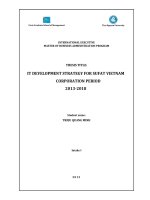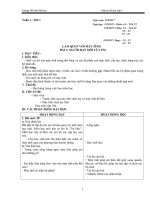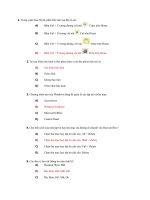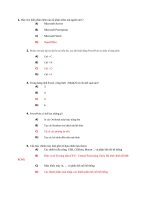Cs224W 2018 9
Bạn đang xem bản rút gọn của tài liệu. Xem và tải ngay bản đầy đủ của tài liệu tại đây (5.79 MB, 8 trang )
Link Prediction between YouTube Videos using
Node Features and Role Attributes
Han Lin Aung,
James
Li, Justin Xu
Stanford University
hanlaung,
dawwctor,
ABSTRACT
YouTube is unequivocally one of the most
prominent content creation and sharing sites
on the Internet. This prominence has transformed YouTube from a video site to a different
kind of social network, connecting subscribers,
commenters, and content creators together to
form a huge network of intermingling social
circles. We are interested in learning more
about how videos within these different social
circles influence each other, and what roles they
play within their communities. In this paper, we
utilize this information to develop and compare
several link prediction algorithms suggesting
new related videos to users. To tackle this, we
looked at a YouTube dataset containing graphs
of related videos and analyzed the emergent
roles and communities within this network to
see how their interplay affected the rest of the
graph’s connections. We found that using Knearest neighbors on a combination of RolX
roles and genres performed the best at predicting accuracy, although Random Forests performed better when we also incorporated node
aggregate features (additional node features).
INTRODUCTION
Our goal is to extract large scale relationships between communities and roles on
YouTube to help us understand how views flow
and progress throughout the YouTube network
through the links offered by the related videos
section. An influx of popularity and links in
one genre may signal an equivalent rise in other
justinx
communities, signalling to content creators that
collaboration between different subsectors of
YouTube communities may be beneficial. Revealing individual metrics of related content
creators or videos can help stretch the bounds
of intersectional content creation,
drawing
to-
gether communities which may seem disparate
but actually have great influence on each other.
We extracted this information by implementing a variety of supervised machine learning
approaches for link prediction using the features extracted within communities, including
role counts obtained from RolX. A link prediction model will point to the relative relationships between communities. We utilized various algorithms, described later in our paper, to
evaluate the efficacy of each method by using
our temporal data to maximize view increase
correlations between different communities.
Moreover, our link prediction model could
also be helpful for everyday users by helping
them find additional related videos not originally anticipated by the original YouTube algorithm. A problem often stated among YouTube
users is the lack of genre diversity of videos
suggested by YouTube. By also including suggestions to videos with similar roles and attributes, but unrelated genres, a YouTube
user
can take greater advantage of the YouTube
platform, enhancing their viewing experience
and world view.
RELATED
WORK
Characterization of the YouTube
Video
Com-
our focus on analyzing these three particular
attributes in our YouTube dataset.
munity
This paper studies YouTube’s topology to
analyze its structural properties and the nature
of the social relationships among users and
between users and videos. It also analyzes various network properties, including user profiles
and video popularities, in order to highlight
the impact of social relationships on a content-
RolX
This is relevant to our work as it deals with
the relationships between videos in terms of
relatedness, the biggest attribute of which is
genre. This paper notes that these videos are
heavily influenced by social relations, although
the tags are determined algorithmically and not
directly through human decision [5]. Other previous work on YouTube mostly considered the
YouTube network from the perspective of users
and subscribers rather than the perspective of
videos and how they relate to each other, as we
do.
for similar nodes [3]. We were interested in this
sharing network like that of YouTube’s
[5].
Characterizing Links, Roles, and Communities
While not explicitly pertaining to YouTube,
this paper nonetheless covers the relationship
between links, roles, and communities in social
networks, which we found to prove useful in
conducting our own analysis of roles and communities within YouTube for link prediction.
This paper analyzes the network structure and
focuses on the roles of key actors in communities in order to glean insights into the
link structure and behavioral characteristics of
nodes within the graph across time [2].
It also identifies nodes acting as key roles in
the graph and displays the relationship between
the combination of influence and roles with
recurrent links between sections of the graph
[2]. Moreover, the paper found that discovered
communities in social networks could be applied for link recommendations for bridging
new communities together. This analysis shows
that roles, communities, and links are all inter-
connected in social network graphs, justifying
In order to determine which roles are present
within
our
data,
we
used
RolX,
which
has
previously proven to be a reliable, scalable way
of determining node roles using unsupervised
learning. This paper developed an algorithm for
extracting roles from a graph which could then
be interpreted and used to classify and search
because it provided a way to extract additional
node features that could be used to identify
relationships between graph sections [3]. This
can easily be repurposed to using these node
properties on YouTube videos to help predict
whether two nodes were likely to form a link,
which is equivalent to determining whether two
videos were likely to be related.
Link Prediction via Supervised Learning
This paper relies on three sets of features:
proximity, aggregated, and topological features
[1]. These features respectively describe the
similarity between nodes, individual properties
of
nodes,
nodes,
and
which
relational
structures
are all then combined
predict link formation
[1]. We
between
to help
took a similar
approach, especially with the topological and
aggregated features, as the roles and communities a node belongs to can have a great effect on
whether a specific YouTube video will become
related to another one.
Furthermore, for our own link predictions
models,
we
considered
many
of the machine
learning models tested in this paper, as even
though our features were different, the underlying models proved robust enough to continue
providing good performance.
DATA
The
Social
located
dataset we used is the ’’Statistics and
Network of YouTube Videos” dataset
at
/>
Each file in the dataset consists of a directed
graph of crawled YouTube videos, with each
video corresponding to a node. Each node
contains information on the uploader, category,
length, view
count,
and other information
we
might consider useful when analyzing the different video roles. A directed edge in the graph
exists from node a to b whenever a video b is
in the first twenty videos of the related video
list of a video a. We did not have to perform
any data collection for our dataset, although we
still aggregated all the graph files to work with
the complete YouTube network.
MATHEMATICAL
BACKGROUND
AND
ALGORITHMS
RolX
To determine
contained,
we
what
used
roles each
the
RolX
video
node
algorithm
to
automatically discover each video’s structural
roles in the YouTube network. To do this,
RolX recursively extracts features based off
the network connectivity features, which are
a combination of local features, like degree,
and egonetwork features, features of the node’s
neighbors and edges located within [3]. It
uses these features to generate additional
by aggregating surrounding features, as
itively, nodes with similar roles must also
similar neighbors
[3].
then
ones
intuhave
After reaching the recursive depth limit,
RolX takes the resulting feature vectors and
partitions the network by assigning each node
a vector of roles it most closely fits. RolX
provides us with a soft clustering of each node
to each role and provides a role-feature matrix,
or alternatively the sense-making matrix, that
maps raw features to each role [3].
Feature Selection
The paper [1] constructs a supervised machine learning model for link prediction by
first selecting which features are appropriate to
use. These features include proximity features,
aggregate features, and topological features.
Proximity features include keywords,
which
can be extracted from the underlying description of the videos, like keywords in a name that
point to the similarity between nodes. Aggregate features are those which sum the values
for particular metrics within a set of nodes,
like view counts and comments for our graph.
We also included role and genre information
into our feature set as categorical variables.
Topological features include those featuring the
underlying connections in the graph. The paper
[4]
provides
various
distance
metrics,
which
we list here, with the most relevant being the
Shortest Distance.
Let G = (V,E) be a directed, unweighted
graph. We denote the set of node v’s direct
neighbors as N(v).
1) Shortest Distance: S(A, B), the shortest
path connecting node A to B
—
C(A, B)
Neighbors:
2) Common
_
IM(4)n N(Đ)|
3) Jaccard Distance: J(A, B) = aay
Binary Classification
We model link prediction as a binary classification problem, as we determine whether
a connection between two nodes will exist,
giving a label of 1 or 0 based on the features be-
tween those nodes. Our dataset uses n(n —1)/2
points,
where
n
is the
number
of nodes
in
our graph G. The paper [1] explains multiple
approaches we used, including SVMs with a
linear/RBF kernel, Random Forest Decision
Trees, K-Nearest Neighbors, and Naive Bayes,
with SVM
overall.
To
RBF
evaluate
links between
kernel
each
performing
model,
we
popular YouTube
the best
tested
videos
our dataset, both from 2007 and 2008.
then measured the recall, precision, and
with
from
We
F1-
score of our models to see how accurately
we predicted link formation. We additionally
considered popularity metrics to see not only
what was currently popular, but what would
become popular through the links we predicted
in the graph.
encapsulating the structure of the network. Furthermore, we constructed a role-features matrix
for each role we extracted, which included raw
features, such as degrees and PageRank, to see
which roles specific roles were actually relevant
and which could be consolidated as one metric
for the number of roles. We also tested with
different number of roles to determine the
optimal number of roles to use for RolX. The
Fig. 1.
results are based on the number of roles (three
Colors represent different genres
roles) that gave us the best output though there
is not a significant difference as we tweak the
number of roles. The number 3 was chosen due
APPROACH
We started by analyzing our data by visualizing various graph attributes. The dataset
includes several depths of the crawl through
the related videos over different time frames.
Some statistics we extracted are shown below
(on the lowest two depth crawl):
1) Number of nodes: 3356
2) Number of edges: 21115
3) Clustering coefficient: 0.69329563953
To
cluster
nodes,
we
relied
on
the
given
genres to identify graph communities. For time
and memory performance reasons, we assumed
that videos of the same genres would naturally
form related clusters,
and to confirm this, we
calculated the proportions of related videos
with the same genres in Figure 1. We found
that for a given video, over half of its related videos, specifically 53.35%, had the same
genres. While difficult to see the connected
nodes in the graph’s center, the peripherals
show us that the related videos of each nodes
are likely to be of the same genre, such as Node
1 in Figure
genres
1. Hence,
videos
will be likely to form
with the same
clusters,
so we
incorporate this information as a feature representing communities into our link prediction
algorithm instead of extracting them through
other methods, like Stochastic Block Modeling.
We also ran RolX on our graph to categorize
our nodes into specific roles to be used as
features for our link prediction algorithms. The
recursive features of RolX incorporated both
local and global network structures, helpful in
to the fact that it was less computational energy
to use fewer number of roles in our feature set.
The feature vector for each of the node
pairs was:
role(m) + role(na)
v(m, N2) =
agg(m) + agg(n2)
abs(agg(m), agg(n›))
genre(m) == genre(na))
Where role(n;) represents the 3 sized vec-
tor representing
the role vector of node
nj.
tics
views,
and
agg(n,)
represents
(comments,
the
3
aggregate
ratings)
genre(n,) is the genre of node n.
for
n;
statis-
We call the RolX features the one generated
from our Roles. RolX + genre including the
genre feature, and RolX + agg + genre including all of the above features.
RESULTS
We
partitioned our results by features and
algorithms used, as well as by the total number
of RolX roles incorporated into our features, as
you can see in Table I.
To get the test set, we constructed features
on the video list for a separate timestamp to
see how well our data generalizes to a different
graph.
To get our validation set, we first extracted
1% of the node pairs from our original graph,
using them as our validation set to test performance on unseen node pairs. We then took
RolX
Random Forest
Logistic Regression
KNN
Train acc
0.603253301
0.582569028
0.958943577
0.527346939
Train precision
Train recall
Train Fl
Val acc
Val precision
Val recall
Val F1
Test acc
Test precision
Test recall
Test Fl
0.715769404
0.342521008
0.463324727
0.860691835
0.010529695
0.37020316
0.020476963
0.748806597
0.002316192
0.429133858
0.004607516
0.615970864
0.438559424
0.512341524
0.727669851
0.007109082
0.492099323
0.014015687
0.880894346
0.002971768
0.25984252
0.00587633
0.924815539
0.999111645
0.960529049
0.856172533
0.025421687
0.952595937
0.049521798
0.862333257
0.001171097
0.118110236
0.002319199
= 0.520364742
0.69877551
0.596515679
0.358747381
0.004404982
0.720090293
0.008756399
0.246217111
0.001765886
0.984251969
0.003525447
RolX + genre
Random Forest
Logistic Regression
KNN
Naive Bayes
Train acc
Train precision
Train recall
Train Fl
Val acc
Val precision
Val recall
Val F1
Test acc
Test precision
Test recall
Test Fl
0.599747899
0.710749252
0.336398559
0.456659551
0.858711866
0.010319068
0.367945824
0.020075128
0.955421385
0.004766561
0.153543307
0.009246088
0.585498 199
0.619041252
0.444609844
0.517522777
0.725183791
0.007108469
0.496613995
0.01401631
0.878563542
0.002914422
0.25984252
0.005764192
0.959039616
0.924942212
0.999159664
0.960619561
0.858205775
0.025777289
0.952595937
0.050196265
0.864354709
0.001386248
0.137795276
0.002744883
0.529651861
0.522157236
0.69877551
0.597691707
0.358747381
0.004404982
0.720090293
0.008756399
0.246217111
0.001765886
0.984251969
0.003525447
RolX + agg + genre
Random Forest
Logistic Regression
KNN
Naive Bayes
Train acc
Train precision
Train recall
Train Fl
Val acc
Val precision
Val recall
Val F1
Test acc
Test precision
Test recall
Test Fl
0.602641056
0.71389973
0.342569028
0.462976183
0.859590866
0.010446525
0.37020316
0.020319663
0.748646587
0.002314717
0.429133858
0.004604596
0.583613445
0.616968394
0.441032413
0.514372121
0.725663245
0.007057072
0.492099323
0.013914598
0.880472988
0.002961235
0.25984252
0.005855736
0.958955582
0.924873864
0.999063625
0.960538313
0.856962745
0.025443751
0.948081264
0.049557522
0.863351983
0.001258356
0.125984252
0.002491824
0.527130852
0.520197326
0.69877551
0.596405664
0.358747381
0.004404982
0.720090293
0.008756399
0.246217111
0.001765886
0.984251969
0.003525447
TABLE I
TRAINING, VAL, AND TEST RESULTS WITH 3 ROLX ROLES
Naive Bayes
the remaining 99% of the node pairs, downsampling the 0 labeled edges to the number
of 1 labeled edges so that we had a balanced
dataset to train on.
Due to the fact that our validation set had
such a few number of 1 labels, the precision
was ultimately very low across the board. However, we can see that when evaluating the recall
values, the models performed better, but the
K-Nearest Neighbors model actually gave us
very high recall values (around .95 across the
board).
To interpret this, our model
to capture
validation
the majority
was
of the edges
set, but also tended
able
in the
to label
some
other node pairs as edges. Comparing the fl
scores (an aggregate of the recall and precision scores), we see that K-Nearest Neighbors
model performed the best.
However, when also looking at our performance
on the test set, we
see that K-Nearest
Neighbors did a lot worse when generalizing
to a new graph. The precision was just as low
and the recall scores dropped down very low,
(to
.13
or
.12)
and
the
fl
scores
of either
the logistic regression or random forest outperforming KNN. This makes sense as the nearest
neighbors of our original graph do not really
correspond to anything in a new graph, so
we can’t really use that information. However,
some of the information does translate when we
use random forest or logistic regression, and
it seems like our model was able to capture
some
of that. All in all, it doesn’t
seem
like
the algorithm was able to generalize very well
though.
However,
when
we
used
all of the
RolX,
genre, and aggregate features, we found that
performance across the board decreased significantly for every algorithm except for Naive
Bayes, which already performed relatively
poorly, and Random Forest.
We can see that there are miniscule differences between the different features we are
using, however, in general we see that the
RolX + genre performed greater had greater
statistics across the board when compared to
just the RolX features. However, when also
adding in the agg features to the mix, we
see that performance across the board tends to
decrease, suggesting that the aggregate features
don’t add much to the model and the RolX
features capturing the majority of the predictive
power.
ANALYSIS
Based
off of our results, we found that K-
Nearest Neighbors performed the best when
using RolX roles or RolX roles combined with
genre communities and considering generalizing to unseen node pairs in our current graph.
Because videos with similar structural roles and
genres in the graph are likely to be related
to each other, it is more
likely that a directed
edge will form between the two corresponding
nodes.
Thus,
we believe K-Nearest Neighbors
performed so well overall because it focused
purely on finding videos that shared these similarities,
so the
features
included
were
well-
suited for the algorithm’s results. Essentially,
because KNN focuses so much on similarity and edges in our YouTube network are
based upon presence in the related video list,
it makes intuitive sense that an algorithm for
determining what other nodes are similar to the
current node would perform so highly on a link
prediction task based on related videos.
For very much the same reasons, it is not sur-
prising that the Random Forest algorithm also
performed well in predicting related videos,
and thus links, in the graph, as the algorithm
also considers nodes based off of similarity,
except between decision trees instead of the
nearest neighbors.
One interesting note is that as soon as we
incorporated aggregate features into our algorithms, the performance of almost all the
machine learning algorithms we used showed
little change, decreasing in some metrics, with
the important exception of Random Forest. As
the aggregate features includes sums and differences of comment and view counts, we suspect
that this discrepancy in performance is due to
the fact that videos are not necessarily related
to each other based off of comment and view
counts, so incorporating this information is
mostly irrelevant. This also explains why KNN
FUTURE
In
the
future,
with
WORK
more
time
and
com-
and view
puting resources, we could experiment with
using other methods of community extraction,
fully to video relatedness, and will thus detract
from link prediction accuracy. Furthermore, it
like Stochastic Block Modeling, to use as our
community features for link prediction, instead
did not decrease, as the multiple decision trees
time and memory
performance
decreased, as comment
count similarities do not contribute meaning-
also explains why Random Forest performance
could simply ignore these additional meaningless features, thus accounting for only the ones
that dealt directly with accurate link prediction,
like roles and genres.
When running our algorithm with a different
number of roles for RolX, we saw little change
in the predictive scores. This suggests that the
patterns in performance decreases we saw stem
from the additional aggregate features used
rather than from the number of total roles
incorporated.
of explicitly using genre. Unfortunately, due to
constraints, we were unable
to incorporate the entire dataset over all time
frames,
since
the
resources
needed
to
load
all of the graphs was rather massive, but we
could attempt this in the future with additional
computing resources. Finally, we could also experiment with using the raw features extracted
from the role-to-features (sense-making) matrix
generated from RolX.
CONTRIBUTIONS
CONCLUSION
In conclusion, because our link prediction
problem is in essence a problem about determining
whether two videos
are related, the
like KNN
and Random Forest. Moreover, only
algorithms that were more suited towards determining similarity performed better overall,
the features that directly dealt with similarity
were useful for our predictions, as videos with
similar genres and similar placements in the
YouTube network were more likely to be related to each other, as not only the videos, but
the videos they were related to, were similar
in many aspects. Overall, we have seen that
RolX is suitable for predicting related videos
in YouTube and that genre can act as an
appropriate substitute for communities when
it comes to deciding whether two YouTube
videos are related. Our algorithms also showed
little promise in the ability to predict nodes for
an unseen graph, which made sense because the
features for the RolX in different graphs were
in different spaces.
1) Han Lin Aung: Performing preliminary
data analysis and coding initial infrastructure to begin processing of the
YouTube related videos network.
2) James Li: Initial problem formulation,
data gathering, researching background
information on RolX, analyzing results,
writing up the report, and making the
poster.
3) Justin Xu: Also coding up the different
algorithms, running tests comparing their
accuracies, and creating graphs of the
YouTube related videos based off of the
resulting information.
PROJECT
CODE
/>
REFERENCES
H]
[2]
[3]
[4]
[5]
Al Hasan, Mohammad, et al. ’Link prediction using supervised learning.’ SDM06: workshop on link analysis,
counter-terrorism and security. 2006.
Atzmueller M. (2014) Social Behavior in Mobile Social
Networks:
Characterizing Links, Roles, and Communities.
In: Chin A., Zhang D. (eds) Mobile Social Networking.
Computational Social Sciences. Springer, New York, NY
Henderson,
Keith,
et al. ’Rolx:
structural
role extraction
& mining in large graphs.” Proceedings of the 18th ACM
SIGKDD international conference on Knowledge discovery and data mining. ACM, 2012.
Sanders,
D-GESS:
Santos,
Lloyd,
et al. “Introduction
to Link
Computational Social Science.
R. L., et al. "Characterizing
Prediction.”
the YouTube
video-
sharing community.” Federal University of Minas Gerais
(UFMG),
Belo Horizonte,
Brazil,
Tech. Rep
(2007).









